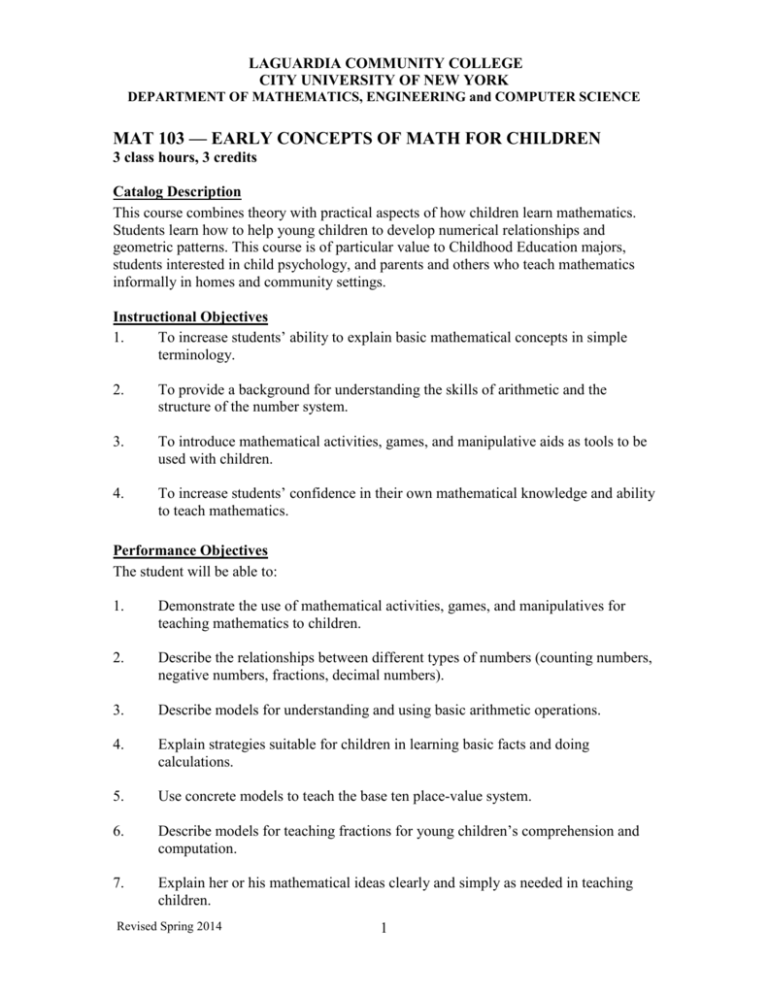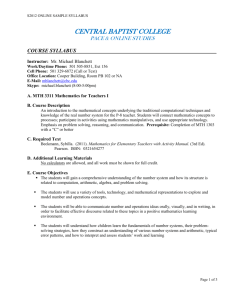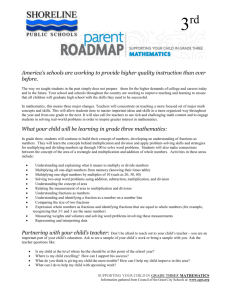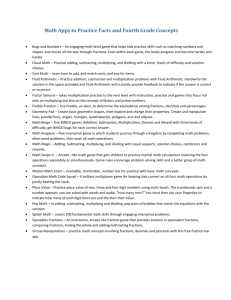MAT103 - LaGuardia Community College
advertisement

LAGUARDIA COMMUNITY COLLEGE CITY UNIVERSITY OF NEW YORK DEPARTMENT OF MATHEMATICS, ENGINEERING and COMPUTER SCIENCE MAT 103 — EARLY CONCEPTS OF MATH FOR CHILDREN 3 class hours, 3 credits Catalog Description This course combines theory with practical aspects of how children learn mathematics. Students learn how to help young children to develop numerical relationships and geometric patterns. This course is of particular value to Childhood Education majors, students interested in child psychology, and parents and others who teach mathematics informally in homes and community settings. Instructional Objectives 1. To increase students’ ability to explain basic mathematical concepts in simple terminology. 2. To provide a background for understanding the skills of arithmetic and the structure of the number system. 3. To introduce mathematical activities, games, and manipulative aids as tools to be used with children. 4. To increase students’ confidence in their own mathematical knowledge and ability to teach mathematics. Performance Objectives The student will be able to: 1. Demonstrate the use of mathematical activities, games, and manipulatives for teaching mathematics to children. 2. Describe the relationships between different types of numbers (counting numbers, negative numbers, fractions, decimal numbers). 3. Describe models for understanding and using basic arithmetic operations. 4. Explain strategies suitable for children in learning basic facts and doing calculations. 5. Use concrete models to teach the base ten place-value system. 6. Describe models for teaching fractions for young children’s comprehension and computation. 7. Explain her or his mathematical ideas clearly and simply as needed in teaching children. Revised Spring 2014 1 Textbook Mathematics for Elementary Teachers with Activity Manual Volume 1 Third Edition (Custom Edition for LaGuardia Community College) Author: Sybilla Beckmann Publisher: Pearson, 2011 Class Activities The manual activities are carefully integrated into the course and the manual is located at the back of Chapter Nine. Please bring your textbook to class so you can participate in these important activities. Grading Your grade in this course will be determined as follows. Test I Test II Project Final Examination 20% 20% 30% 30% Project Your project involves an observation in a classroom followed by two pieces of writing based on what you observe. You’ll write an observation report and a lesson plan. Here’s how the project will work. First, you’ll need to set up your observation: 1. Choose a school you would like to visit and give the name of the school to your instructor so that he/she can write a letter of introduction for you. 2. Take your letter to the school and present it to the principal. 3. The principal will then assign you to a particular teacher. 4. Contact the teacher to set up a date and time for your observation. Make sure the teacher knows that you need to observe a mathematics lesson! During the observation, write down all you can about what’s going on. You can handwrite your notes or use a tablet or whatever lets you get down the most information. You’ll use your notes to write an observation report. Your observation report should include the following elements. State the school and the grade level you visited. Indicate anything special about the class — bilingual program, “gifted and talented” students, special-needs children, etc. Describe the classroom setting — how many students, the type of room, how the seats are arranged, what’s on the walls, etc. State the mathematics topic that was covered. Describe all the teaching strategies used during the lesson. Include a description of any worksheets, books, manipulatives, visual aids, electronic devices, and other materials that were used. Give examples of problems, questions, and activities that the teacher demonstrated and the children worked on. Give examples of students’ oral and written responses on the work they did. Revised Spring 2014 2 Describe how the students behaved during the lesson — both overall and the behavior of particular students. Describe the homework assigned as a follow-up. Give your opinion on how well the homework reinforces this lesson and leads into the next one. Talk about how good a lesson you think this is for teaching mathematical skills. Talk about how good a lesson you think this is for helping children to understand mathematics. The last component of the project is the lesson plan. You have two choices. If you believe that you can make major improvements to the lesson you observed, then write a new lesson plan for the topic. OR If you’d teach the topic pretty much the same way the teacher did, then write a plan for a lesson following up on the one you observed. Weekly Outline Possible Exercises (instructors will give the actual assignments) Week Topics Sections Pages 1 Chapter 1 1.1 1.2 1.3 1.4 Chapter 2 2.1 2.2 2.3 2.4 2.5 2.6 Chapter 3 3.1 3.2 1 2-11 11-25 25-32 32-35 38 39-48 48-53 53-57 58-68 68-78 78-89 92 93-100 100-110 3.3 111-120 pp. 118-120, 1-15 3.4 3.5 Chapter 4 4.1 4.2 121-132 132-137 140 140-146 147-149 pp. 130-132, 1-26 p. 137, 1-4 4.3 150-163 pp. 159-163, 1-26 4.4 163-172 pp. 171-172, 1-18 2 3 4 Numbers and the Decimal System The Counting Numbers Decimals and Negative Numbers Comparing Numbers in the Decimal System Rounding Numbers Fractions The Meaning of Fractions Interlude: Solving Problems and Explaining Solutions Fractions as Numbers Equivalent Fractions Comparing Fractions Percent Addition and Subtraction Interpretations of Addition and Subtraction The Commutative and Associative Properties of Addition, Mental Math, and Single-Digit Facts Why the Common Algorithms for Adding and Subtracting Numbers in the Decimal System Work Adding and Subtracting Fractions Adding and Subtracting Negative Numbers Multiplication Interpretations of Multiplication Why Multiplying Numbers by 10 is Easy in the Decimal System The Commutative and Associative Properties of Multiplication The Distributive Property Revised Spring 2014 3 p. 11, 1-8 pp. 23-25, 1-15 pp. 31-32, 1-16 p. 35, 1-7 pp. 45-48, 1-22 None p. 57, 1-8 pp. 65-68, 1-26 pp. 76-78, 1-20 pp. 88-89, 1-23 pp. 99-100, 1-6 pp. 109-110, 1-13 p. 146, 1-8 p. 149, 1-5 5 6 7 8 9 10 11 12 Properties of Arithmetic, Mental Math, and Single-Digit Multiplication Facts Why the Common Algorithm for Multiplying Whole Numbers Works Review for Test I Test I Multiplication of Fractions, Decimals, and Negative Numbers Multiplying Fractions Multiplying Decimals Multiplying Negative Numbers Powers and Scientific Notation Division Interpretations of Division Division and Fractions; Division with Remainder Division Why the Common Long-Division Algorithm Works Fraction Division from the “How Many Groups?” Perspective Fraction Division from the “How Many In One Group?” Perspective Dividing Decimals Combining Multiplication and Division: Proportional Reasoning The Meanings of Ratio, Rate, and Proportion Solving Proportion Problems by Reasoning with Multiplication and Division Connecting Ratios and Fractions When You Can Use a Proportion and When You Cannot Percent Revisited: Percent Increase and Decrease Number Theory Factors and Multiples Greatest Common Factor (GCF) and Least Common Multiple (LCM) Prime Numbers Even and Odd Numbers Divisibility Tests Number Theory Rational and Irrational Numbers Looking Back at the Number Systems Review for Test II Test II Algebra Mathematical Expressions and Formulas Equations Solving Equations Review for Final Examination Revised Spring 2014 4 4.5 173-182 pp. 179-182, 1-18 4.6 182-191 pp. 189-191, 1-13 Chapter 5 194 5.1 5.2 5.3 5.4 Chapter 6 6.1 6.2 194-202 203-207 207-210 210-217 219 219-226 226-234 pp. 200-202, 1-22 pp. 206-207, 1-12 p. 210, 1-3 pp. 216-217, 1-12 6.3 6.4 234-250 250-258 pp. 246-250, 1-27 pp. 256-258, 1-16 6.5 258-266 pp. 264-266, 1-14 6.6 266-274 Chapter 7 277 pp. 272-274, 1-16 7.1 278-284 pp. 283-284, 1-8 7.2 7.3 7.4 284-295 295-299 299-301 pp. 292-295, 1-25 pp. 298-299, 1-5 pp. 300-301, 1-8 7.5 301-312 Chapter 8 314 8.1 314-318 pp. 309-312, 1-27 8.2 8.3 8.4 8.5 318-325 325-330 331-334 334-338 pp. 323-325, 1-20 p. 330, 1-7 pp. 333-334, 1-12 pp. 337-338, 1-15 8.6 8.7 338-351 352-353 pp. 349-351, 1-20 p. 353, 1-2 Chapter 9 9.1 9.2 9.3 356 357-366 367-375 375-380 pp. 363-366, 1-25 pp. 372-375, 1-17 pp. 379-380, 1-7 p. 226, 1-8 pp. 232-234, 1-16 pp. 317-318, 1-9






